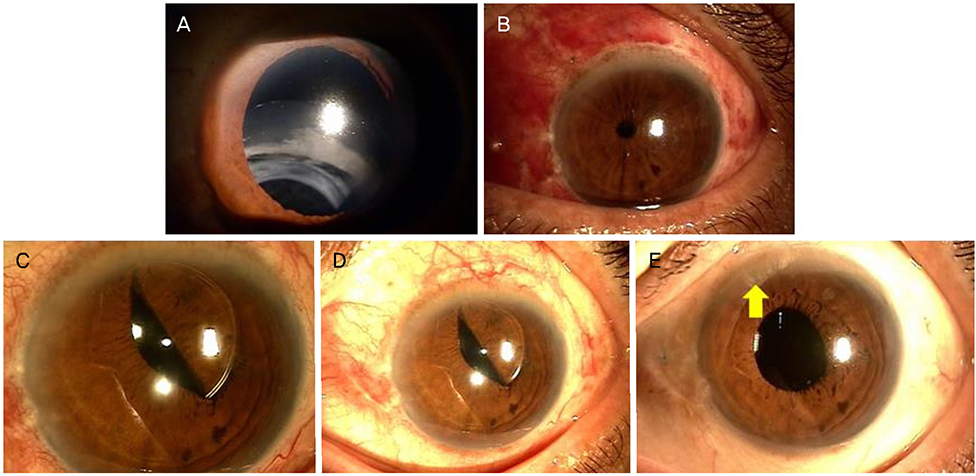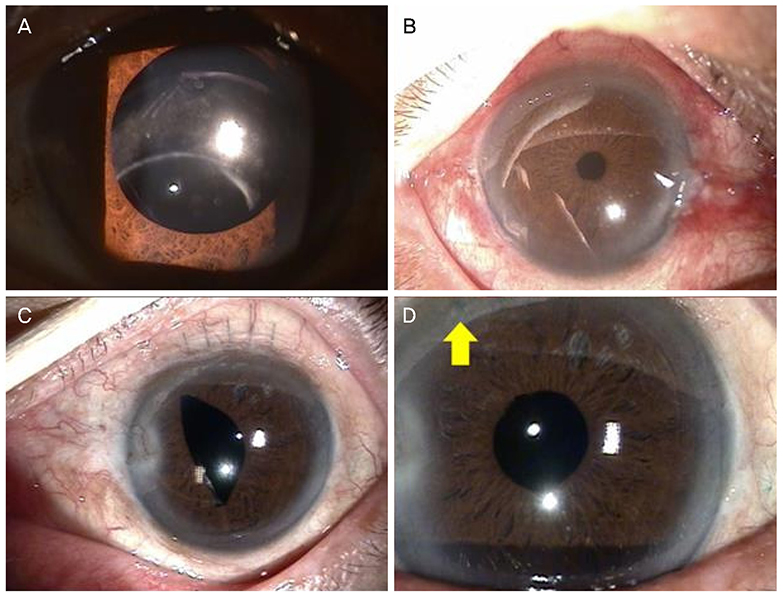J Korean Ophthalmol Soc.
2019 Apr;60(4):387-392. 10.3341/jkos.2019.60.4.387.
Two Cases of Intraocular Lens Pupillary Optic Capture Treated with Argon Laser Iridotomy
- Affiliations
-
- 1Department of Ophthalmology, Dankook University College of Medicine, Cheonan, Korea. perfectcure@hanmail.net
- KMID: 2443157
- DOI: http://doi.org/10.3341/jkos.2019.60.4.387
Abstract
- PURPOSE
We report two cases of intraocular lens (IOL) pupillary optic capture following IOL scleral fixation treated with argon laser iridotomy.
CASE SUMMARY
(Case 1) A 69-year-old man presented with suddenly decreased visual acuity of the left eye. The best-corrected visual acuity was finger count (FC) 30 cm in the left eye. Slit lamp examination revealed subluxation of the left eye IOL. An IOL scleral fixation and anterior vitrectomy were performed and no specific findings were observed. During the follow-up period, pupillary optic capture was repeated without specific causes, such as trauma, or IOL decentration thus, argon laser iridotomy was performed. (Case 2) A 77-year-old man presented with a 3-day history of congestion of the left eye and decreased visual acuity. Best-corrected visual acuity was 0.4 logarithm of the minimum angle of resolution (logMAR) in the left eye. Slit lamp examination revealed subluxation of the left eye IOL. An IOL scleral fixation and anterior vitrectomy were performed, and no specific findings were observed. During the follow-up period, pupillary optic capture was found, and IOL repositioning and argon laser iridotomy were performed.
CONCLUSIONS
Laser iridotomy can be used to prevent recurrence of pupillary optic capture in eyes with IOL scleral fixation without decentration or distortion.
Keyword
MeSH Terms
Figure
Reference
-
1. Ridley H. Intra-ocular acrylic lenses--past, present and future. Trans Ophthalmol Soc U K. 1964; 84:5–14.2. Malbran ES, Malbran E Jr, Negri I. Lens guide suture for transport and fixation in secondary IOL implantation after intracapsular extraction. Int Ophthalmol. 1986; 9:151–160.
Article3. Holt DG, Young J, Stagg B, Ambati BK. Anterior chamber intraocular lens, sutured posterior chamber intraocular lens, or glued intraocular lens: where do we stand? Curr Opin Ophthalmol. 2012; 23:62–67.4. Hannush SB. Sutured posterior chamber intraocular lenses: indications and procedure. Curr Opin Ophthalmol. 2000; 11:233–240.
Article5. Fernández-Buenaga R, Alio JL, Pérez-Ardoy AL, et al. Late in-the-bag intraocular lens dislocation requiring explantation: risk factors and outcomes. Eye (Lond). 2013; 27:795–801. quiz 802.
Article6. Por YM, Lavin MJ. Techniques of intraocular lens suspension in the absence of capsular/zonular support. Surv Ophthalmol. 2005; 50:429–462.
Article7. Solomon K, Gussler JR, Gussler C, Van Meter WS. Incidence and management of complications of transsclerally sutured posterior chamber lenses. J Cataract Refract Surg. 1993; 19:488–493.
Article8. Teichmann KD, Teichmann IA. The torque and tilt gamble. J Cataract Refract Surg. 1997; 23:413–418.
Article9. McAllister AS, Hirst LW. Visual outcomes and complications of scleral-fixated posterior chamber intraocular lenses. J Cataract Refract Surg. 2011; 37:1263–1269.
Article10. Heilskov T, Joondeph BC, Olsen KR, Blankenship GW. Late endophthalmitis after transscleral fixation of a posterior chamber intraocular lens. Arch Ophthalmol. 1989; 107:1427.
Article11. Bading G, Hillenkamp J, Sachs HG, et al. Long-term safety and functional outcome of combined pars plana vitrectomy and scleral-fixated sutured posterior chamber lens implantation. Am J Ophthalmol. 2007; 144:371–377.
Article12. Johnston RL, Charteris DG, Horgan SE, Cooling RJ. Combined pars plana vitrectomy and sutured posterior chamber implant. Arch Ophthalmol. 2000; 118:905–910.13. Davison JA. Capsule contraction syndrome. J Cataract Refract Surg. 1993; 19:582–589.
Article14. Moon AR, Moon NJ, Choi KY. Long-term results and complications using scleral-fixated posterior chamber intraocular lenses. J Korean Ophthalmol Soc. 1996; 37:1283–1292.15. Herschler J. Trabecular damage due to blunt anterior segment injury and its relationship to traumatic glaucoma. Trans Sect Ophthalmol Am Acad Ophthalmol Otolaryngol. 1977; 83:239–248.16. Singh H, Safran SG, Ahmed II. Laser iridotomy for pseudophakic reverse pupillary block in patients with pupillary optic capture after sulcus-placed intraocular lenses. J Cataract Refract Surg. 2017; 43:299.
Article17. Narang P, Agarwal A. Pupilloplasty for pupil size attenuation to prevent pupillary capture: theory of quintet in glued IOL. J Cataract Refract Surg. 2017; 43:3–7.
Article
- Full Text Links
- Actions
-
Cited
- CITED
-
- Close
- Share
- Similar articles
-
- Modified Rectangular Loop Suture for Refractory Pupillary Optic Capture of Scleral Fixated Intraocular Lens
- The Effect of 1 % Apraclnidine on Intraocular Pressure Following Argon Laser Iridotomy and Laser Trabeculoplasty
- Effect of Combined Argon Laser Peripheral Iridoplasty and Laser Iridotomy in Primary Angle-Closure Glaucoma
- Argon Laser and Nd-YAG Laser Combined Iridotomy
- Comparison of Diode-Pumped, Frequency-Doubled Neodymium: YAG Laser and Blue-Green Argon Laser Iridotomy



